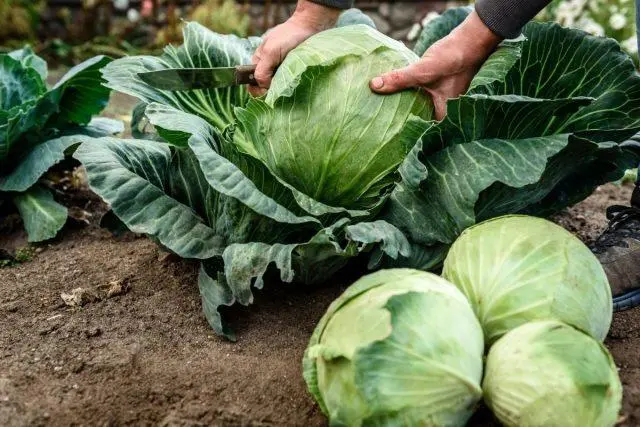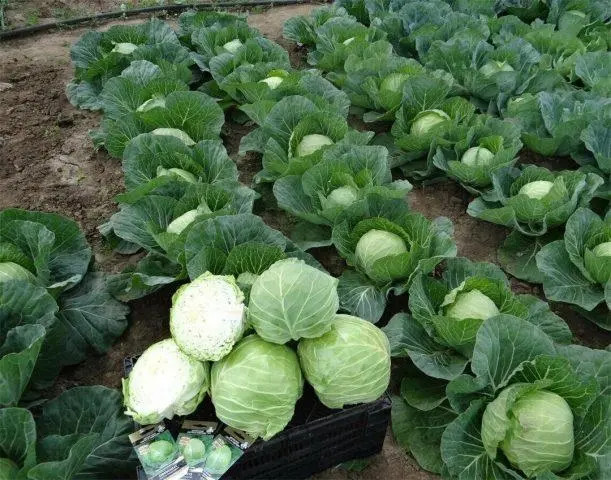Contents
It is necessary to feed cabbage in July with compounds of potassium, phosphorus and boron. They stimulate the growth of heads, improve setting, and also strengthen the root system. For effective top dressing, mineral and organic compounds are introduced. It is allowed to use folk recipes.
Signs of a Nutrient Deficiency
Macro- and microelements play an important role in plant nutrition, including cabbage. Therefore, even on very fertile soil, plantings need to be periodically fed – up to four times per season (from the moment they are transplanted into the ground).
It is especially important to fertilize if a deficiency of one or another element is found. Nitrogen deficiency is determined by the following signs:
- slow development, seedlings practically stop growing;
- chlorotic color of leaves – with yellow, pale shades;
- lower foliage acquires bluish tones;
- on the reverse side of the leaf plates, you can see reddish blotches (they run parallel to the main vein);
- heads of cabbage are clearly smaller, the yield decreases.
To prevent such phenomena, you need to feed the cabbage with nitrogen compounds. You can give urea, mullein infusion or complex fertilizers. If a clear lack of nitrogen is detected, any saltpeter is added.
Another vital element is phosphorus. With its deficiency, the following symptoms appear:
- leaves acquire a rich dark green, bluish color;
- petioles may become purple or even purple;
- foliage dies off, covered with black spots;
- plants are far behind in flowering and head formation.
To restore balance, cabbage in July should be fed with superphosphate (simple or double).
In some cases, plants lack potassium – the main symptoms are:
- old foliage becomes burnt, young – dull;
- leaf plates turn yellow and die, the surface of the remaining ones becomes wrinkled;
- partially acquire a bluish tint, “bronze”;
- the edges begin to curl;
- a strong delay in the formation of buds and flowering.

Signs of potassium deficiency
Fertilization Rules
You can feed cabbage in the middle of summer with different compositions. In this case, the following rules must be observed:
- The main purpose of feeding cabbage in July is to form an ovary. For this, it is worth using compounds of phosphorus, potassium and boron. Nitrogen is used to a minimum.
- Fertilizers should have a balanced composition – it is best to use complex preparations in combination with organic matter.
- When preparing the solution, the dosage must be carefully observed. Overfeeding cabbage is more dangerous than underfeeding. Do not think that the more you feed, the better the yield – it is important to observe the measure.
- Before and after fertilizing in July, the soil should be loosened. Also, if necessary, carry out weeding.
- It is better to feed cabbage in July in the root way, i.e. just pour under the root. If the liquid gets on the leaves, it is important to wash it off with water from under the hose.
- It is better to feed with fertilizers in the late evening or early morning. On the eve of application, it is recommended to water the soil so that the substances reach the root system faster.
- For white and red cabbage, the substances are taken in the concentrations indicated in the instructions. All other varieties should be fed with fertilizers taken 1,5-2 times less.
- If the soil is chernozem, top dressing is also taken in a reduced amount.
early cabbage
The principles of feeding early and late varieties of cabbage are the same – they are described above. But since these are different cultures, there are certain differences. Early ripe varieties ripen within 90-110 days. Therefore, after transplanting into the ground, it is enough to feed twice – in June and early July. After that, after a few weeks, the crop is harvested.
Late cabbage
Late cabbage, unlike early cabbage, should be fed up to 3-4 times per season:
- directly when planting in the ground;
- at the beginning of July;
- in the middle of July;
- then the last time in August 2-3 weeks before harvest.
They are planned two weeks after transplantation. Then the compositions are made according to the schedule in July and August.

Late varieties of cabbage fertilize 3-4 times per season
Top dressing of cabbage in July in the open field for the formation of heads
Any varieties of cabbage in July need to be intensively fed for the active formation of heads. It is recommended to use mineral and organic compounds. Folk remedies are also used, for example, infusion of cut grass or fermented yeast.
Mineral feed
Mineral top dressing of cabbage in July is brought in to form heads of cabbage. They are sold in the form of powders that are highly soluble in water. In most cases, root dressing is carried out, i.e. water is poured directly under the root (about 1 liter per plant).
To form forks in July, you can feed different varieties of cabbage with the following compositions:
- Dissolve superphosphate (3 tablespoons) with potassium salt (2 tablespoons) in a standard bucket of water, mix and water.
- Take superphosphate (3 large spoons) and potassium sulfate (also 2 tablespoons), dissolve in 10 liters and pour.
- Dilute 3-4 g of boric acid powder in a small amount of hot liquid, then after dissolution, dilute to 10 liters. Carry out root processing.
You can also feed the plants in July with special complex compounds, for example, Mortar. Take a tablespoon with a slide (15 g), add 2 tbsp. l. superphosphate and dissolved in 10 l. Watered in the calculation of a maximum of 5 liters per 1 m2. You can use other means, for example, “Kemira” or “Agricola”.
For good knotting, it is recommended to use mixed formulations. For example, you can take 30 g of superphosphate and mix it with mullein infusion 1:5, dilute in 5 liters, water several plants (1,3-1,5 liters per bush).
Organic Fertilizers
Top dressing of cabbage in July for the growth of heads can also be done with organic compounds. As a rule, they are prepared in advance, at the end of June. The most common infusion of mullein or bird droppings. To prepare them, proceed as follows:
- They take raw materials, fill a fifth of the container.
- Fill to the top with water.
- Leave for 10-15 days.
- Stir occasionally.
- Then diluted 10 times (mullein) or 15-20 times (litter).
- Watered, spending 500 ml of the finished liquid on each bush.

Regular fertilizing with organic matter ensures a high yield
Potassium humate (100 ml per 10 l), as well as complex compositions (for example, mullein with superphosphate) can also be used. With these funds, it is worth feeding the cabbage in July and August, no later than two weeks before harvesting.
Fertilizing cabbage in July with folk remedies
Quite effective as a top dressing and folk remedies. They are very easy to prepare. The main recipes are:
- Take a bag of dry yeast (10-12 g) and dissolve in warm water (bucket). Then add 2-3 tbsp. l. sugar and mix thoroughly. Leave overnight in a warm place, stirring occasionally. Feed cabbage 1 liter per plant. If the soil is depleted, the dosage can be doubled – 2 bags of yeast (20 g) per bucket of water.
- You can take any bread (white, gray, fresh or stale) and put in 10 liters of water. Leave for a day, then mix and add 30 drops of iodine tincture. Mix, dilute with water 1: 3 and start watering. This tool is used to feed and increase pH. The infusion is especially useful on acidic soils.
- You can also feed cabbage in July with such a folk remedy as an infusion of freshly cut grass (nettle is especially useful). Weeds are crushed, half the volume of the container is filled up and filled to the top with water. Infuse for 7-10 days, mix, then pour through a sieve or gauze and dilute with water three times.
- You can also feed cabbage in July with an infusion of wood ash – 200 g in 10 liters of warm water. Leave for a few hours and start watering. If there is no time, the ash can simply be scattered over the surface in a small layer (only powdered). Then pour over with water.
- Another good way to feed plantings in July is an infusion of onion peel. Take 500 g, insist in 3 liters of boiling water for 3-4 days and filter. Then dilute 1:10 and start watering.
Conclusion
You can feed cabbage in July with various preparations, observing an interval of two weeks. Experienced summer residents recommend using both mineral components and liquid organics. At the same time, it is important to observe the dosage so as not to spoil the soil and not harm the plants themselves.









